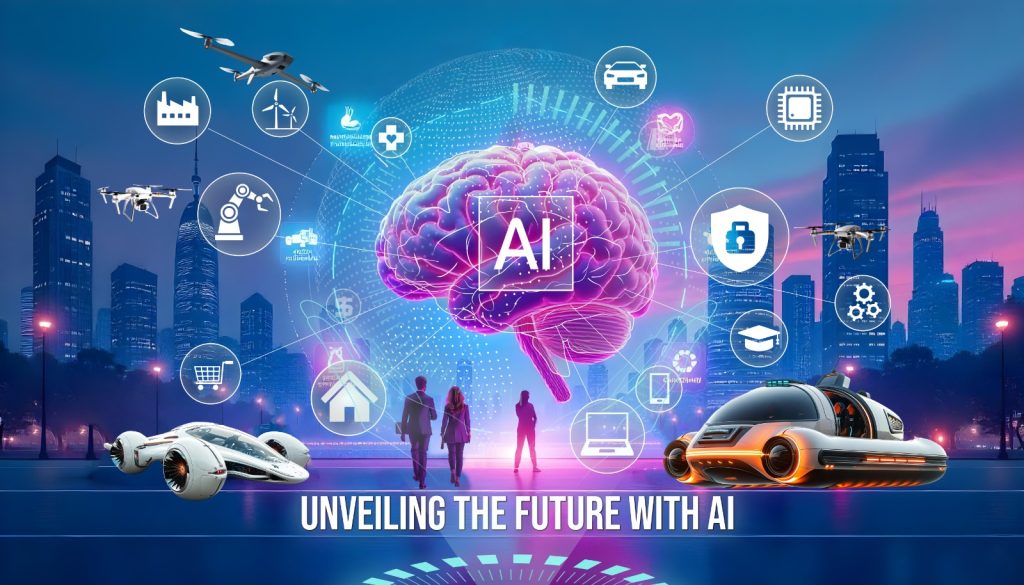Unveiling the Future: AI’s Promising Journey in the Next Decade
Artificial Intelligence has transcended the boundaries of science fiction and established itself as a transformative force across industries. The next decade promises even greater advancements, as AI continues to shape societies, redefine industries, and unlock human potential. Join us in exploring the fascinating future of AI and its boundless possibilities.
AI Everywhere
AI will become ubiquitous, seamlessly integrated into various aspects of daily life. From personalized healthcare and smart cities to autonomous vehicles and virtual assistants, AI will revolutionize industries and redefine human interactions. The era of hyper-personalization will arrive, with AI tailoring products, services, and experiences to individual preferences and needs. Through vast data analysis, recommendation systems and virtual assistants will deliver interactions that anticipate and fulfill user desires (Marr, 2020).
AI Augmentation
Rather than replacing humans, AI will enhance human intelligence and capabilities. The rise of AI-powered tools and systems will empower individuals and organizations to achieve unprecedented levels of productivity and efficiency. By augmenting decision-making processes, AI will help us tackle complex challenges across domains such as business, healthcare, and education (Brynjolfsson & McAfee, 2017).
AI-Driven Healthcare Revolution
AI holds the potential to revolutionize healthcare, enabling early disease detection, personalized treatment plans, and the development of new therapies. Over the next decade, AI-powered diagnostics, telemedicine solutions, and precision medicine will improve patient outcomes and make healthcare more accessible. For example, AI algorithms are already being used to detect cancer at earlier stages and predict disease progression (Topol, 2019).
AI-Enabled Sustainability
As global challenges such as climate change and resource scarcity intensify, AI will play a crucial role in addressing these issues. AI-driven technologies will optimize renewable energy usage, monitor environmental changes, and enable sustainable agricultural practices. By leveraging AI, humanity can mitigate the environmental impact of human activities and promote a greener future (Rolnick et al., 2019).
AI-Powered Creativity
AI will augment human creativity, fostering innovation in art, music, film, and design. From generating music and visual art to assisting in storytelling and production, AI will collaborate with creatives to push the boundaries of artistic imagination. This partnership will lead to new forms of cultural expression and innovation (McCormack et al., 2019).
AI-Driven Education Transformation
The future of education will be shaped by AI’s ability to offer personalized learning experiences tailored to individual student needs. AI-powered platforms will provide adaptive learning, virtual tutors, and immersive educational experiences, revolutionizing knowledge acquisition and dissemination. By making education more inclusive and effective, AI will help bridge learning gaps worldwide (Holmes et al., 2019).
AI and Autonomous Systems
Autonomous vehicles, drones, and robots will transform transportation, logistics, and manufacturing. AI will enable these systems to navigate complex environments, make real-time decisions, and adapt to changing conditions. This new era of automation will improve efficiency and safety across industries (Goodall et al., 2019).
AI for Social Good
AI will address pressing social challenges such as poverty, inequality, and humanitarian crises. AI-driven initiatives will enhance disaster response, public health, and humanitarian aid efforts, contributing to more resilient and equitable societies. Data-driven insights will guide impactful innovations, creating a sustainable and just future (Vinuesa et al., 2020).
Deepening Human-AI Collaboration
The next decade will see AI systems evolve beyond automation to true collaboration with humans. Natural language processing and machine learning advancements will allow AI to function as a personal assistant, enabling more efficient communication, creativity, and decision-making (Amershi et al., 2019).
Democratization of AI
As AI technology becomes more accessible, it will

empower individuals across industries and backgrounds. By lowering barriers to entry, AI will reduce inequalities and drive innovation in healthcare, education, and agriculture. This democratization will ensure that AI’s benefits are shared globally (Marcus & Davis, 2019).
Improved Trust and Explainability
To foster trust in AI systems, researchers will prioritize transparency, explainability, and fairness. Future AI models will not only make accurate predictions but also provide insights into their decision-making processes. Explainable AI will enhance user confidence and understanding (Lipton, 2018).
Emergence of Edge AI
AI will increasingly operate on edge devices like smartphones, drones, and smart cameras, enabling real-time analysis and faster decision-making. Edge AI will enhance privacy and security while unlocking new applications in augmented reality, autonomous systems, and the Internet of Things (Xu et al., 2018).
Multimodal and Human-Centric AI
AI systems will evolve to process and generate data across multiple modalities, such as text, images, audio, and video. This multimodal approach will create more comprehensive and human-like AI systems capable of nuanced understanding and communication. A human-centric approach to AI development will ensure that its impact aligns with societal values and well-being (Shneiderman, 2020).
Embracing the AI-Powered Future
The next decade promises to be an exciting and transformative journey for AI. By embracing the challenges and opportunities ahead, we can harness AI’s transformative potential to drive innovation, empowerment, and positive change. Together, we can shape a future where AI serves humanity as a powerful force for good.
For further assistance, visit our channel and refer this video link below
Future of AI | AI in next 10 years | Futuristic AI: Turilytix BIG-AI

References
- Shor, P. W. (1997). “Polynomial-Time Algorithms for Prime Factorization and Discrete Logarithms on a Quantum Computer.” SIAM Journal on Computing.
- Lloyd, S. (1996). “Universal Quantum Simulators.” Science.
- Preskill, J. (2018). “Quantum Computing in the NISQ Era and Beyond.” Quantum.
- Arute, F., et al. (2019). “Quantum Supremacy Using a Programmable Superconducting Processor.” Nature.
Share This :


Thank you, your article surprised me, there is such an excellent point of view. Thank you for sharing, I learned a lot.